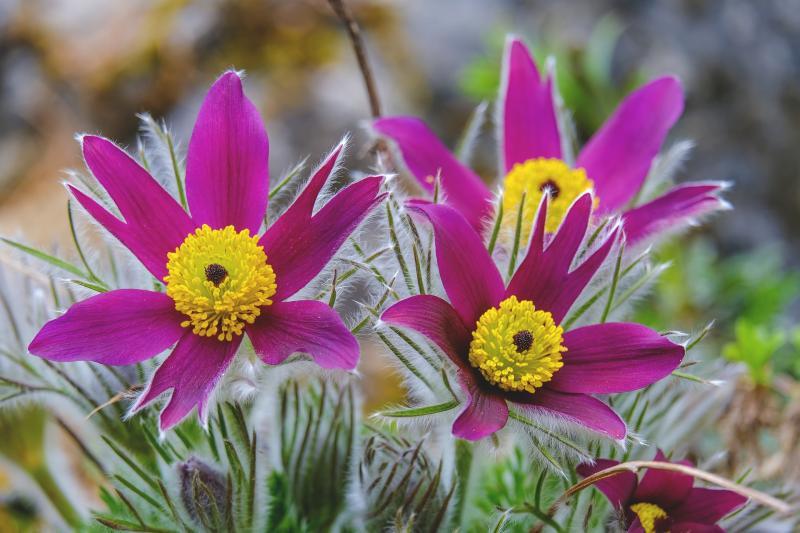Sarah Browning, Nebraska Extension Educator

Pasque flower, Pulatilla vulgaris, is a beautiful early spring flower for a dryland prairie garden.
Maybe you have dreamed of creating a small wildflower garden in your landscape? If so, a great place to start is with an dryland prairie garden. Not too tall, but full of color and wildflowers! Just make sure the site you chose is in full sun- to perform at their best these plants require full sun at least 6 hours or more a day.
Creating a Dryland Prairie Garden
Upland prairies are always well-drained and are the driest prairies in this area. Upland prairie plants are usually knee-high or less. This garden should always have a base planting of little bluestem (Schizachrium scoparium), sideoats grama (Bouteloua curtipendula), prairie dropseed (Sporobolus heterolepis) or blue grama (Bouteloua gracilis). Cool-season grasses, such as needlegrass, (Stipa spartea) and our native fesque sedge (Carex brevior) should also be considered. When planning a border using plants native to dryland soils it is essential to improve the drainage of your site by raising the soil above the original grade by several inches or more. I use a mixture of ½ topsoil and compost.
I use a 1-2" layer of grass clippings or wood chips mulch on my dryland garden for topdressing: to provide a nice, uniform cover; xeric plants like to reseed in this mulch; weeding is easy by cutting the young weeds with a hoe just under the mulch. Be careful not to apply to much mulch, excessive wood chips can hold too much moisture for these plants and they can develop crown rot.
Recommended Plants for the Dryland Prairie Garden
Early spring blooming gems include: Pasque Flower (Pulsatilla patens), Dwarf spiderwort, (Tradescantia tharpii), Prairie Phlox, (Phlox pilosa), Prairie Smoke (Geum triflorum), Fremont's Clematis (Clematis fremontii).
Mid-spring to early summer beauties include: Dwarf Blue Indigo (Baptisia minor), Evening Primrose (Oenothera missouriensis), Butterfly Milkweed (Asclepias tuberosa), Leadplant (Amorpha canescens), Prairie Skullcap (Scutelleria resinosa), Pale Purple Coneflower (Echinacea pallida), Purple Prairie Clover (Dalea purpurea), Purple Poppy Mallow (Callirhoe involucrata).
Late summer to fall: rosinweed, Silphium integrifolium, Royal catchfly (Silene regia), Rattlesnake master (Eryngium yuccafolium), Aromatic Aster (Aster oblongifolius), Dotted Gayfeather (Liatris punctata).
Short-Lived Prairie Plants For Re-Seeding
These wildflowers are nice additions to the prairie garden and although they are short-lived (1-3 years) they should still be included in your design. These beauties perpetuate in the garden by reseeding themselves. You can gather or order seed and sow it where you want it or let them seed out on their own and the garden becomes unpredictable, just like a real prairie. The following plants are all dryland species and are best sited in well-drained soils. They love seeding in gravel mulch!
- Combine Brown-Eyed Susan (Rudbeckia triloba) with Sand Lovegrass (Eragrostis trichoides)
- Try Wild Larkspur (Delphinium virescens) with Lance-leaf Coreopsis (Coreopsis grandiflora)
- Plant Prairie Junegrass (Koelteria pyramidata) with Prairie Ragwort (Senecio plattensis) and Blue Flax, (Linum perenne)
- A hot summer combination of Plains coreopsis, (Coreopsis tinctoria), Scarlet Rocket (Ipomopsis aggregate) and bitterweed (Helenium amarum)
- Combine Shell-leaf Penstemon (Penstemon grandiflorus) with Whorled Milkweed (Asclepias verticillata)
Source: Bob Henrickson, Nebraska Statewide Arboretum
Search Our Archive
Associated Video
Raising Nebraska Prairie
Nebraska Extension Landscape Horticulture Specialist Kim Todd gives us a tour of the Raising Nebraska Prairie at the Nebraska State Fairgrounds in Grand Island